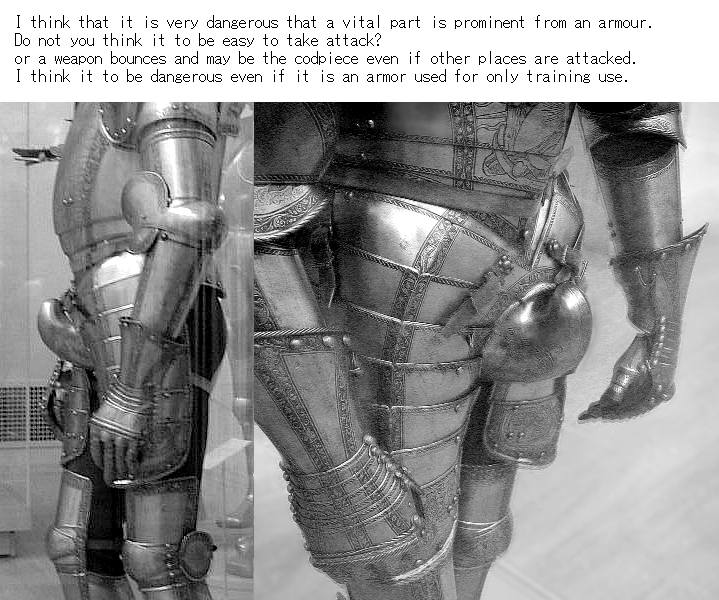Thank you for a lot of replies!
and I'm sorry my reply is too late...(I spent long time to translated Japanese... I am sorry that I cannot reply to all members...)
Dear Lancelot Chan
>BTW, since you're located in Japan and are interested in medieval arms and armors, have you contacted Jay Noyes of Avalon group?
I know that site.
This myArmoury site has lots members. and I asked this question in this BBS.
Dear Sean Flynt
> I have read that German Landsknecht mercenaries, who were prone to flashy dress, sometimes used their codpieces as purses.
> So, codpieces could theoretically protect a man's valuables, just not in the way we imagine.
> Learn more here:
>
http://en.wikipedia.org/wiki/Codpiece
thanks.
I read Wikipedia or other site before, and I thought that "Why needs codpieces(for purses) for the armour?"
Dear Robert MacPherson
> The division between the tassets happens at or just above the level of the pubic bone.
> This must be the case so that the legs can move freely enough to walk.
> The gap between the tassets must be wide enough to accommodate a saddle.
> This leaves a lot of the lower abdomen and the inguinal area protected only by mail.
> Quite aside from the unpleasant possibility of injury to the genitals, this is vital and lethal target area.
> I am sure the men at arms of the sixteenth century were more than pleased to hang a piece of plate in the gap when they were not mounted.
> Its defensive value was no doubt like that of the besagews they hung in front of their (likewise only mail protected) arm pits.
Thank you for teaching it in detail.
(I know "Quite aside from the unpleasant possibility of injury to the genitals, this is vital and lethal target area.".
So I think "Why a vital part was projection?")
Dear Craig Peters
> In my experience, the groin isn't the easiest location to attack.
> The reason I say this is because it is difficult to specifically hit a codpiece with a cut.
> You're far more likely to hit the leg or the hip with a cut first.
> So that means that a lot of the attacks made with a sword, at least, are not likely to strike it.
> On the other hand, a thrust is still very dangerous, and it's not too difficult to hit someone in the groin when thrusting.
> It can also be possible to hit someone's codpiece with a vertically rising cut, although this is still relatively uncommon.
Thank you for teaching it in detail.
(By the fight that used a sword or polaxe... I thought that the "projection" more easily hit than the "flat".)
Dear Folks
> Also remember that the codpiece , or brayette, in the later 16th century is usually attached to the lower lame of the fauld
> ( the skirt attached to the bottom of the breastplate),
> so any blow hitting the codpice would be absorbed somewhat by the mass of the breastplate,
> as well as all the various padding worn underneath the armour. The earlier, larger, and more famous,
> codpieces associated with King Henry VIII, are much more substancial affairs, that are strapped to the body,
> and cover the whole area surrounding the groin,
> and as the genitals are not actually in the codpiece a direct hit is not likely to bring tears to the wearers eyes,
> providing that the codpiece is fitted correctly.
Thank you for teaching it in detail.
> Your English is good, and quite understandable. I wish that my Japanese was as good !
thanks ^^
